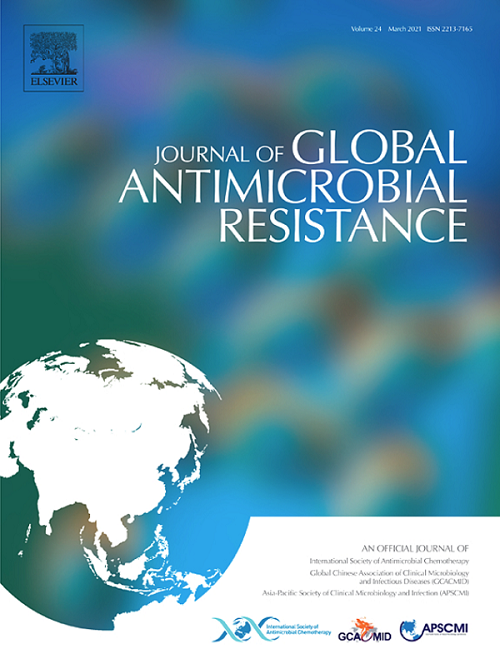Vancomycin-resistant Enterococcus faecium: A current perspective on resilience, adaptation, and the urgent need for novel strategies
IF 3.7
3区 医学
Q2 INFECTIOUS DISEASES
引用次数: 0
Abstract
Vancomycin-resistant Enterococcus faecium (VREfm) has become a critical opportunistic pathogen, urgently requiring new antimicrobial strategies due to its rising prevalence and significant impact on patient safety and healthcare costs. VREfm continues to evolve through mutations and the acquisition of new genes via horizontal gene transfer, contributing to resistance against several last-resort antibiotics. Although primarily hospital-associated, VREfm are also detected in the community, food chain, livestock, and environmental sources like wastewater, indicating diverse transmission pathways and the need for a One Health approach. Advances in genomics have shed light on VREfm's persistence in hospital settings, particularly its adaptation to the gastrointestinal tract of hospitalized patients, recent clonal shifts, and the dominance of specific clonal lineages. Despite extensive research, significant gaps remain in understanding the molecular mechanisms behind VREfm's unique adaptation to clinical environments. In this review, we aim to present an overview of VREfm current prevalence, mechanisms of resistance, and unveil the adaptive traits that have facilitated VREfm's rise and global success. A particular focus is given to key plasmids, namely linear plasmids, virulence factors, and bacteriocins as potential drivers in the global emergence of the ST78 clonal lineage. We also address diagnostic challenges and the limited treatment options available for VREfm, as well as emerging antibiotic alternatives aimed at restoring gut microbiota balance and curbing VREfm proliferation. A multifaceted approach combining research, clinical practices, and public health policies is crucial to mitigate the impact of this superbug and preserve antimicrobial effectiveness for future generations.
万古霉素耐药屎肠球菌:当前对恢复力、适应性和新策略的迫切需求的看法。
耐万古霉素屎肠球菌(VREfm)已成为一种重要的机会致病菌,由于其日益上升的患病率和对患者安全和医疗成本的重大影响,迫切需要新的抗菌策略。VREfm通过突变和通过水平基因转移获得新基因继续进化,有助于对几种最后手段的抗生素产生耐药性。虽然主要与医院有关,但在社区、食物链、牲畜和废水等环境来源中也发现了VREfm,这表明传播途径多种多样,需要采取“同一个健康”方针。基因组学的进展揭示了VREfm在医院环境中的持久性,特别是其对住院患者胃肠道的适应性,最近的克隆转移以及特定克隆谱系的优势。尽管进行了广泛的研究,但在了解VREfm对临床环境的独特适应背后的分子机制方面仍存在重大差距。在这篇综述中,我们旨在介绍VREfm目前的流行情况,抗性机制,并揭示促进VREfm兴起和全球成功的适应性特征。特别关注关键质粒,即线性质粒,毒力因子和细菌素,作为ST78克隆谱系全球出现的潜在驱动因素。我们还讨论了VREfm的诊断挑战和有限的治疗方案,以及旨在恢复肠道微生物群平衡和抑制VREfm增殖的新兴抗生素替代品。将研究、临床实践和公共卫生政策相结合的多方面方法对于减轻这种超级细菌的影响并为子孙后代保持抗菌效果至关重要。
本文章由计算机程序翻译,如有差异,请以英文原文为准。
求助全文
约1分钟内获得全文
求助全文
来源期刊

Journal of global antimicrobial resistance
INFECTIOUS DISEASES-PHARMACOLOGY & PHARMACY
CiteScore
8.70
自引率
2.20%
发文量
285
审稿时长
34 weeks
期刊介绍:
The Journal of Global Antimicrobial Resistance (JGAR) is a quarterly online journal run by an international Editorial Board that focuses on the global spread of antibiotic-resistant microbes.
JGAR is a dedicated journal for all professionals working in research, health care, the environment and animal infection control, aiming to track the resistance threat worldwide and provides a single voice devoted to antimicrobial resistance (AMR).
Featuring peer-reviewed and up to date research articles, reviews, short notes and hot topics JGAR covers the key topics related to antibacterial, antiviral, antifungal and antiparasitic resistance.
 求助内容:
求助内容: 应助结果提醒方式:
应助结果提醒方式:


